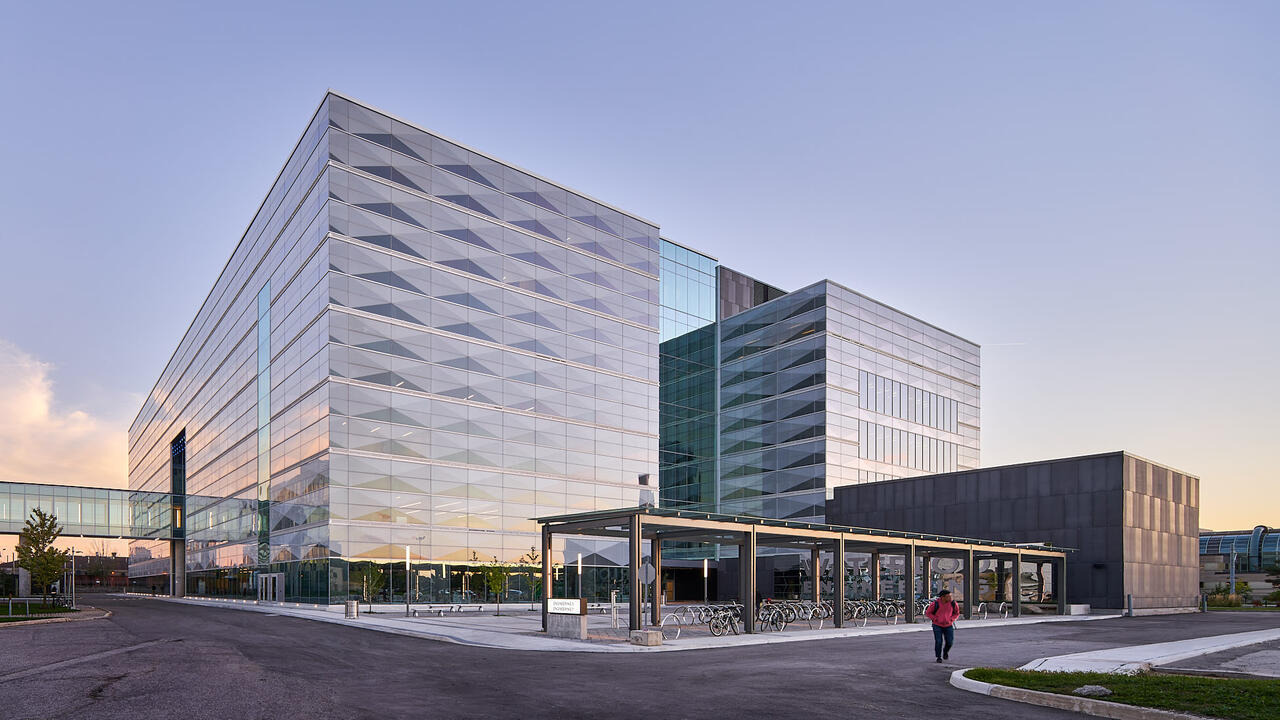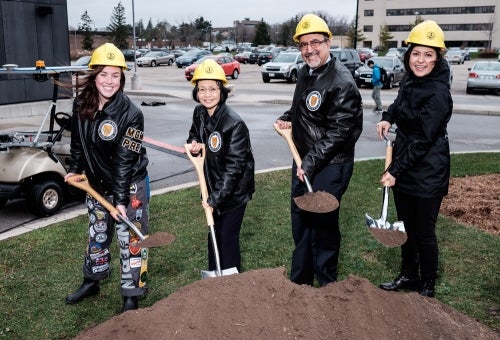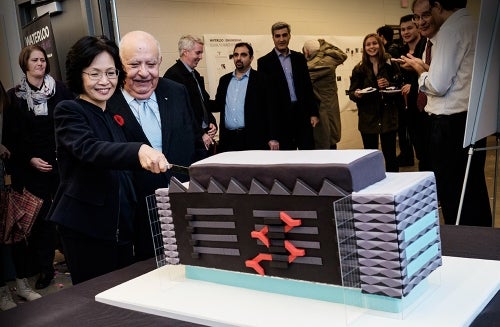
New E7 building will transform how engineers are educated
Self-driving vehicles and robots built by Waterloo engineers helped break ground on Engineering 7 building

Self-driving vehicles and robots built by Waterloo engineers helped break ground on Engineering 7 building
By Angela Pause Faculty of EngineeringConstruction of the Faculty of Engineering's new Engineering 7 (E7) building began at a ground-breaking event that included robots, autonomous vehicles and good old-fashioned shovels.
As several hundred students, alumni, faculty, staff and donors watched a live video stream of the event on November 12, Dean of Engineering Pearl Sullivan, along with University President Feridun Hamdullahpur, tossed shovels of dirt into the air, officially launching the construction of the 242,000 gross-square-foot building that will be one of the largest facilities on campus.

Hannah Gautreau, engineering student and president of EngSoc B, Pearl Sullivan, dean of engineering, University of Waterloo President Feridun Hamdullahpur and Elahe Jabari, PhD candidate in mechanical and mechatronics engineering, put shovels in the ground at E7 groundbreaking event.
The groundbreaking festivities included the acknowledgement of several significant gifts from private sector donors, including two anonymous gifts of $25 million and $10 million. Also in attendance were Jacques and Céline Lamarre whose family foundation gifted $1.5 million in support of the construction of Engineering 7. Other major gifts to the Educating the Engineer of the Future campaign were also announced including more than $1 million each from General Motors of Canada, Magna International Inc., and Toyota Motor Manufacturing Canada Inc.
“When I look around, I see people who truly believe in Waterloo Engineering. People who know we are deeply committed to Educating the Engineer of the Future and they have generously supported our fundraising campaign so we can accomplish these four crucial things: Build Engineering 7, enhance student experience, establish Chairs in emerging technologies and support graduate students,” said Sullivan, just before donning a Waterloo Engineering hard hat and leather jacket and jumping into an autonomous golf cart with President Hamdullahpur.
The $70 million campaign, publicly launched in April of this year, has reached the $55 million mark from private sector donations alone. The new E7 facility will feature an additive manufacturing—or 3D printing—laboratory and a RoboHub for testing autonomous and robotic vehicles.
It will also accommodate growth from Waterloo’s new biomedical engineering program and the expansion of the Faculty of Engineering’s highly popular mechatronics engineering program. It will house the Faculty’s new teaching innovation, the multidisciplinary Engineering Ideas Clinic™, where undergraduate students will integrate classroom theory with hands-on learning as they design, build, test and refine ideas.
A student-centric building, there is dedicated study and social spaces, lecture halls and entrepreneurial support areas, along with 20 design garages for student design teams to prototype their Capstone Design projects.
EllisDon will construct the building that will also become the permanent home for the Conrad Business, Entrepreneurship and Technology Centre, and the Engineering Outreach unit, which offers STEM education programs for elementary and high school children, such as Engineering Science Quest and Go ENG Girl.
Hannah Gautreau, president of EngSoc B and Elahe Jabari, PhD candidate in Mechanical and Mechatronics Engineering, also lent a hand to break ground, as Steve Waslander, professor of mechanical and mechatronics engineering, narrated the journey for the indoor audience as they viewed the entire event on large screens inside a packed Sedra Student Design Centre. As soon shovelfuls of dirt were tossed in the air, confetti cascaded on the cheering crowd.

Dean Pearl Sullivan and Adel Sedra slice up a delicious replica of the new E7 building
The groundbreaking event also featured high-profile Waterloo Engineering student and alumni technology. The autonomous golf cart, developed by Varden Labs, a Waterloo Engineering student-founded company, was the first autonomous vehicle to operate on a public road in Canada last August. The Husky robot that carried the shovels is a product of Clearpath Robotics, a highly successful company founded by Waterloo Engineering alumni in 2007. Even the film crew capturing the event was co-founded by Waterloo alumni, Angle Media Group. Alas, not all went as planned - the 70 kph winds prevented Vertical, another Waterloo Engineering alumni firm, from flying their cinematography drone during the groundbreaking ceremony.
“This event was exciting for everyone and we’re looking forward to Engineering 7’s grand opening in September 2018 when we’ll have even more thrilling student, researcher and alumni innovations to showcase,” said Sullivan.

Read more
Here are the people and events behind some of this year’s most compelling Waterloo stories

Read more
Meet five exceptional Waterloo graduate students crossing the convocation stage as Class of 2025 valedictorians

Read more
Waterloo Engineering alum wears her iron ring proudly while building her career in quantum tech in Germany
The University of Waterloo acknowledges that much of our work takes place on the traditional territory of the Neutral, Anishinaabeg, and Haudenosaunee peoples. Our main campus is situated on the Haldimand Tract, the land granted to the Six Nations that includes six miles on each side of the Grand River. Our active work toward reconciliation takes place across our campuses through research, learning, teaching, and community building, and is co-ordinated within the Office of Indigenous Relations.